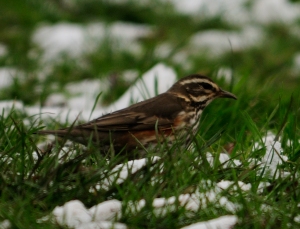Thanks to Winterwatch, I’ve had to completely rethink this blog. I had an idea to write a blog in defense of an animal that is regularly vilified. There are, after all, plenty of candidates- Fox, Rat, and Magpie all immediately spring to mind. I’d chosen a species so lowly regarded that it’s most frequent comparison isn’t even a member of the same class! It’s a bird that’s compared to a mammal, the rat with wings, the Feral Pigeon. 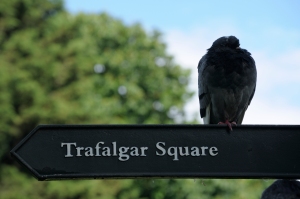 So I had this idea and started thinking about what to include. Then on came Winterwatch, and lo and behold- a segment defending pigeons! It wouldn’t be so bad, but this has happened before. The blog I wrote about reintroducing the Lynx, I’d started writing when BBC Wildlife Magazine fell through the letterbox with what was essentially the same article within it’s pages. So I had to put that one off for a few months (but I will admit to using the stats they printed. They were better detailed than the ones I’d found, so I swapped!)
So I had this idea and started thinking about what to include. Then on came Winterwatch, and lo and behold- a segment defending pigeons! It wouldn’t be so bad, but this has happened before. The blog I wrote about reintroducing the Lynx, I’d started writing when BBC Wildlife Magazine fell through the letterbox with what was essentially the same article within it’s pages. So I had to put that one off for a few months (but I will admit to using the stats they printed. They were better detailed than the ones I’d found, so I swapped!)
So, with not having a usable article and it having been a while since the last one (again) I thought I’d revert to one of my favourite topics, and one I haven’t covered for a while- appreciating the wildlife around us. I’m going to also mention the snowy weather, but don’t worry- it’s contextual and relevant.
Yesterday, I had a 45 minute walk to a Job Link interview, which apart from a 5 minute walk by the side of the cemetery was entirely in housing estates, and the whole journey was through 3 inches of snow. I was struck by the number of species I saw. Some of them (Wren, Great Tit, Blue Tit, Long-tailed Tit, Robin, House Sparrow, Pied Wagtail, Starling, Blackbird, Magpie, Jackdaw, Carrion Crow, Woodpigeon), I’d have been surprised not to see, but some of the birds that are normally seen less regularly are being forced out in the open more. Birds like Coal Tit, Treecreeper, Nuthatch, Blackcap, Dunnock, Greenfinch, Goldfinch, Song Thrush, and Collared Dove. I grant you that in some areas, several of these birds are out and bold as brass as a matter of course (Collared Doves and Goldfinches for example), but around here (or at least on my usual routes) they are less commonly seen.
Something else thing to look out for in areas with grass and trees like parks or village greens are Redwing (above). These look like Thrushes with rusty armpits (mainly because they are.) You can see them in towns and cities without too much fuss, and if this area is anything to go by, there are a lot about at the moment. 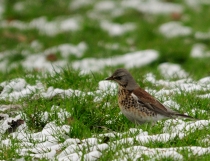 Another Thrush around this time of year to look out for is the Fieldfare (left). This grey-headed Thrush is less easily seen, but the weather is making it easier to find them. They’ll very often be seen in flocks of Redwing- so look properly! On the return walk, I was fortunate to witness a Crow mobbing a Peregrine, which went on for a couple of minutes. I’ve seen them mob Buzzards, Ravens and Gulls fairly often, but never anything as small as that. This leads me to something else I’d like to tell you about. A couple of weeks ago, in a school playing field opposite Tesco, I saw 6 out of our 8 native Corvids.
Another Thrush around this time of year to look out for is the Fieldfare (left). This grey-headed Thrush is less easily seen, but the weather is making it easier to find them. They’ll very often be seen in flocks of Redwing- so look properly! On the return walk, I was fortunate to witness a Crow mobbing a Peregrine, which went on for a couple of minutes. I’ve seen them mob Buzzards, Ravens and Gulls fairly often, but never anything as small as that. This leads me to something else I’d like to tell you about. A couple of weeks ago, in a school playing field opposite Tesco, I saw 6 out of our 8 native Corvids. 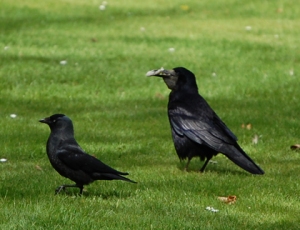 A Corvid is a member of the crow family, or Corvidae. In Britain we have 8 members, the Raven, Carrion Crow (or simply, Crow!) Hooded Crow, Rook, Jackdaw, Magpie, Jay, and Chough. The only 2 I didn’t see were the Hooded Crow and the Chough. As neither are found in this area, that makes it a local full-set! Hopefully I’ve demonstrated that, despite the “bad” weather, there are still plenty of things to be looking out for.
A Corvid is a member of the crow family, or Corvidae. In Britain we have 8 members, the Raven, Carrion Crow (or simply, Crow!) Hooded Crow, Rook, Jackdaw, Magpie, Jay, and Chough. The only 2 I didn’t see were the Hooded Crow and the Chough. As neither are found in this area, that makes it a local full-set! Hopefully I’ve demonstrated that, despite the “bad” weather, there are still plenty of things to be looking out for.
Why are we able to see so many species? Well, it’s simple. It’s hard finding food in this weather. Everything’s frozen or too cold to emerge, so birds are having to be bolder in their hunt for something to eat. As some species need to eat as much as 50% of their own bodyweight in food every day, I think it’s important to help them. You don’t have to have a birdfeeder to be able to help them- you can put food out anywhere, in the branches of trees, garage or shed roofs, on the ground, it really doesn’t matter. The main thing to look out for is predators- including local cats- and if there are some in your area, make sure that where you’re putting the food isn’t making the birds easy prey. What to give them? Again, easy. Fat balls, peanuts, sunflower seeds, nyjer seeds (or niger, or nyger), mixed seeds, dried invertebrates (worms, bugs etc- a commonly found one is dried mealworms), and if your local pet shop caters for reptiles, live waxworms. Putting these different things out will make sure you have a nicely balanced catering service to cater for most species. If you need advice, the RSPB and DK books have a great book called Bird Feeder by Robert Burton. It retails at £16.99, but The Works sell it for £6 – £7. At this time of year, don’t try to attract new species to your garden, simply cater for the one’s in the area. If you’re not confident in your identification, then just put out the things mentioned above. After a while, you’ll get to know what you have and will be able to tailor your table accordingly.
Another important point is not to be put off if the birds don’t come- there could be many reasons why not. 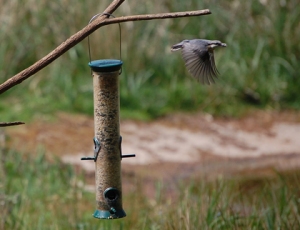 Common reasons are local cats, dogs or foxes, somebody else is putting out all the food they need, or they’re simply not used to feeding there. At home, we put out everything mentioned above, and this time of year, it’s only the fatballs they’re interested in. Then one morning, all the dried inverts had gone! Just because they haven’t touched something, doesn’t mean they won’t. They know what they need way better than you ever will. Sure, it’s disheartening throwing away a full-feeder’s worth of food to replace it with another, but if you don’t, who will help them on the day’s they need it? Remember, if they’re not at your feeders, it’s probably because at the moment they’re feeding elsewhere, so it’s a good thing really. But it’s no guarantee that it’ll continue that way, so persevere. And don’t forget to clean the feeders regularly- if seeds sprout, that’s okay, but keep an eye out for mould, and ALWAYS make sure they have clean, fresh water available.
Common reasons are local cats, dogs or foxes, somebody else is putting out all the food they need, or they’re simply not used to feeding there. At home, we put out everything mentioned above, and this time of year, it’s only the fatballs they’re interested in. Then one morning, all the dried inverts had gone! Just because they haven’t touched something, doesn’t mean they won’t. They know what they need way better than you ever will. Sure, it’s disheartening throwing away a full-feeder’s worth of food to replace it with another, but if you don’t, who will help them on the day’s they need it? Remember, if they’re not at your feeders, it’s probably because at the moment they’re feeding elsewhere, so it’s a good thing really. But it’s no guarantee that it’ll continue that way, so persevere. And don’t forget to clean the feeders regularly- if seeds sprout, that’s okay, but keep an eye out for mould, and ALWAYS make sure they have clean, fresh water available.
Just before I go, I’ve had two exciting sightings in the last week that have excited me, both at Porthkerry Park. One was a Firecrest. I’m fairly certain it was at least. I’ve seen a few Goldcrests up there, but this one had a very definite orange streak rather than the yellow, and it was on the edge of the bushes only 3 or 4 feet from where we were standing (and the dogs were roaming), which illustrates what I was saying about the weather affecting behaviour. 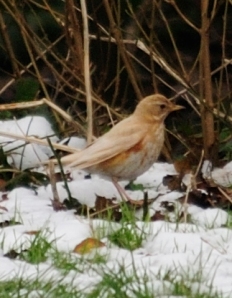 The other one, I’m looking for help with. Firstly I apologise for the quality of the picture (right), but it was taken from a few hundred metres with a 500mm lens on a murky day. I then had to crop the tiny bit out and enlarge it just to get it to this! It’s a Redwing, of that there’s no doubt. But it’s very pale. It was part of a flock of about 100-120 birds, and it’s behaviour was practically the same as theirs. It was a tiny bit more alert, and when it flew into the trees, seemed to favour a mid-height branch every time, whereas the others didn’t seem to care. The rest of the flock seemed to accept it without any problem- in fact, if it wasn’t for the colour, you wouldn’t notice anything at all. Can anyone help?
The other one, I’m looking for help with. Firstly I apologise for the quality of the picture (right), but it was taken from a few hundred metres with a 500mm lens on a murky day. I then had to crop the tiny bit out and enlarge it just to get it to this! It’s a Redwing, of that there’s no doubt. But it’s very pale. It was part of a flock of about 100-120 birds, and it’s behaviour was practically the same as theirs. It was a tiny bit more alert, and when it flew into the trees, seemed to favour a mid-height branch every time, whereas the others didn’t seem to care. The rest of the flock seemed to accept it without any problem- in fact, if it wasn’t for the colour, you wouldn’t notice anything at all. Can anyone help?

